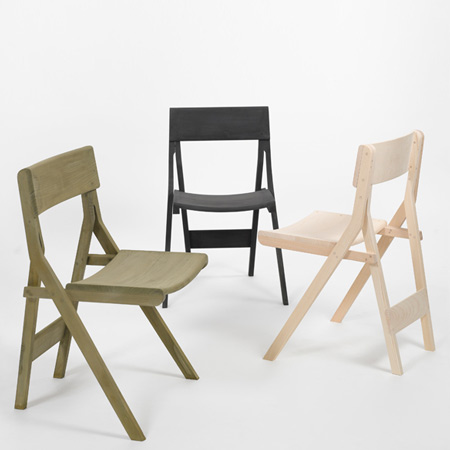
Postfossil at Milan 2010
Milan 2010: Design collective Postfossil will launch a new collection of furniture as part of the SaloneSatellite at the Salone Internazionale del Mobile in Milan next week, including these wooden chairs joined together with adhesives naturally present in the timber.
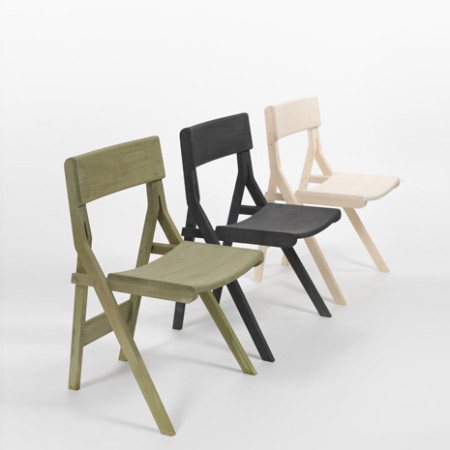
Called Just Wood Chair 2, the seating is constructed using adhesives naturally present in the wood, which are released by the heat generated when dowels are inserted.
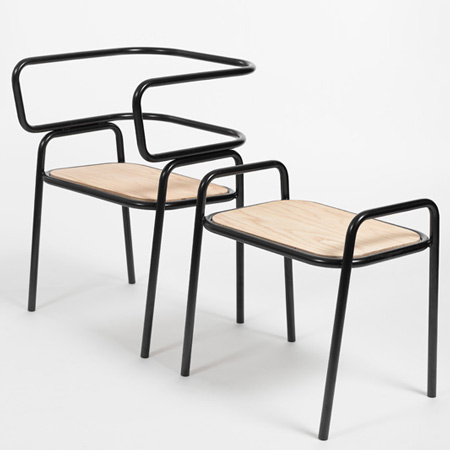
Above: Reflect Chair and Ottoman by Thomas Walde. The chair, through its form, aims to encourage reflection and meditation which in this day and age is often suppressed by other activities. The reduction to structure and naked realisation activate the user and their thoughts. The size and high armrests inspired by Corbusier’s LC2 typologically bring to mind an easy chair, however, it does not allow for much more than to sit down in it, meditate or open a book. The element in front of it corresponds to an ottoman which can also be used as repository or as a stool. Materials: Steel pipe, black.
Other pieces on show will include bottles divided in two for wine water, and a chair made of bent tubular steel with a wooden seat (above and below).
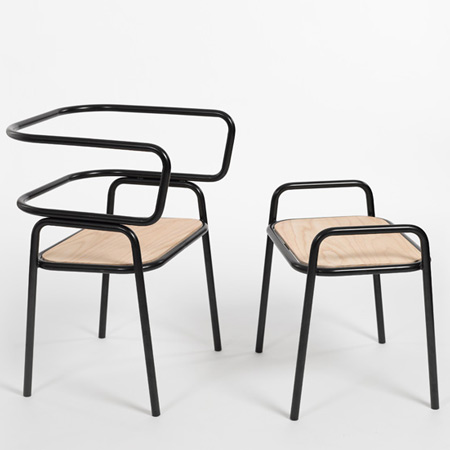
See all our stories about Milan 2010 in our special category.
Photographs are by Philipp Hänger. Captions are provided by the designers.
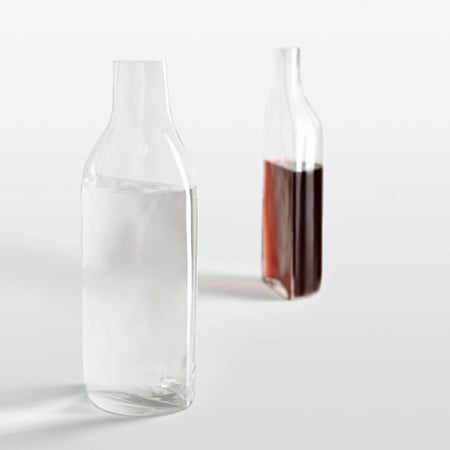
Above: Deuxpiece by Florian Hauswirth. divided – united. An assemblage between a water and a wine jug. With a good meal you should enjoy good wine and clear water. Mineralwater gets transported around the world needlessly – especially to those areas where clean water is available from the tap. Wine consists of water. The grape is transformed into a colourful, precious liquid through skillful handicraft, knowledge and time. This postfossil designproject should motivate to drink local water from taps.
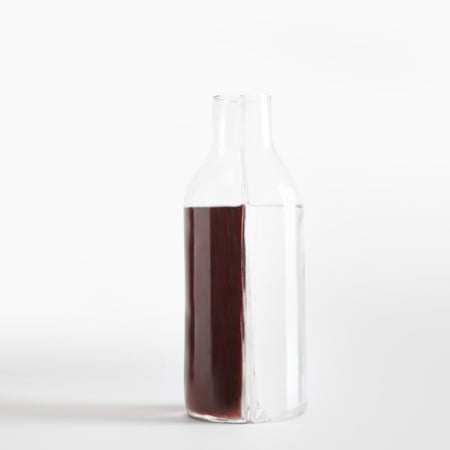
The semi-circular form is easy to handle. Additionally it creates a spout through which the pouring is made easy and which prevents dribbling. For the production of deuxpiece liquid glass was blown into the form. The hardened bottle itself holds any liquid and animates to play with the different colours and levels of its contents. Material: Glass.
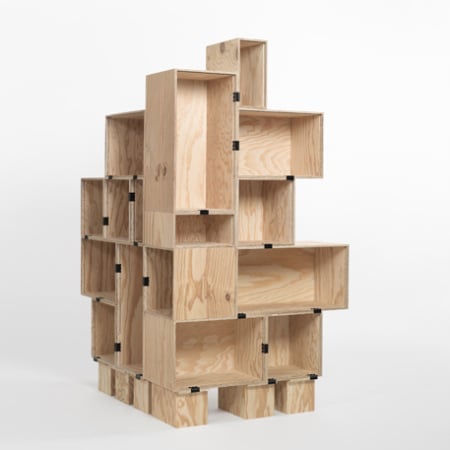
Above: Containersystem 1530 by Daniel Gafner. With the container system „1530“ several needs can be covered, whether as a room partition or as a side table, you can create the most diverse structures. The simple container elements made from french seapine plywood are based on a raster of 15 and 30 centimetres.
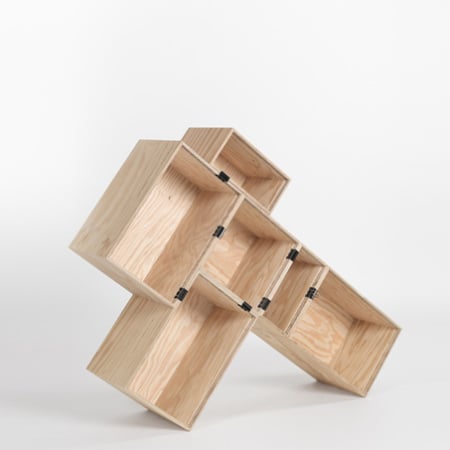
The prominent fluting of the containers allows for a tool-less yet extraordinarily stable interlinkage of the elements with standard foldback pegs. The system „1530“ is the evolution of a travelling library for a collection of art books. The stacking of moving boxes in order to avoid clearing out and putting back in the books every time, was the idea for this library.
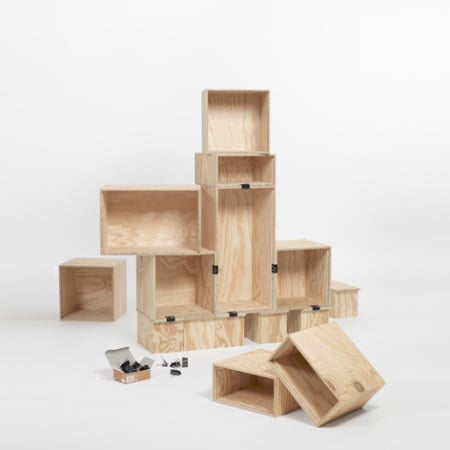
Through the reduction to four aligned formats and the possibility of easy, tool-less interlinkage the system can house various sizes of books, media and other objects. Through the matching base element the containers are not directly placed on the floor and are thus better protected from dirt and dust.
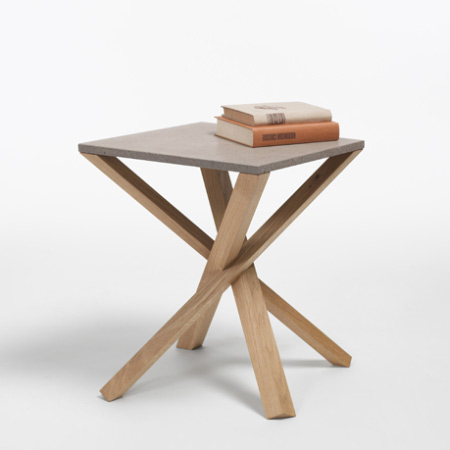
Above: Pic by Christine Birkhoven. This table is not only unusual in its form, but also in its combination of materials. The legs made from naturally oiled oak and act almost like a dancer carrying the untreated andesite stoneplate in a rhombus form.
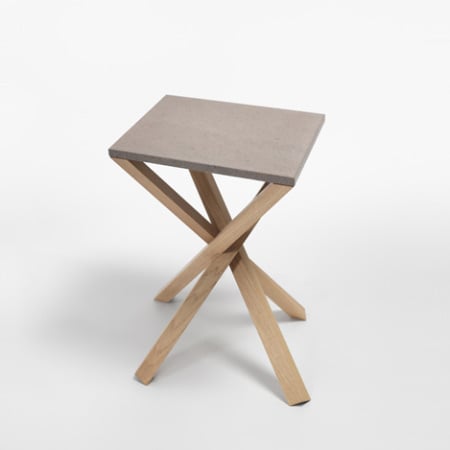
The natural materials stone and wood do not need additional connections: on the underside of the stoneplate are drilled holes which anchor the legs of the table. The weight of the stone gives the table the necessary stability.
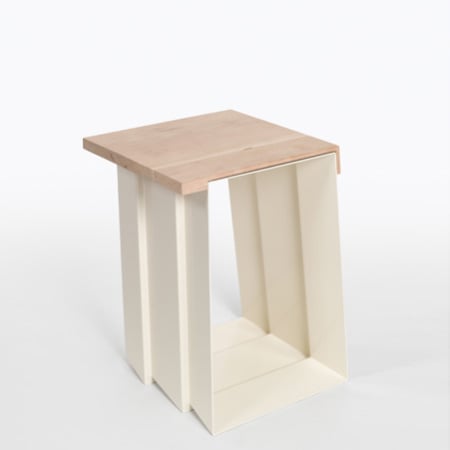
Above: Sgabello by Claudia Heiniger. Sgabello is a simple object which, through its asymmetrical form, indicates the different possibilities for use. The materials sheet metal and solid wood are merged structurally and functionally, whilst at the same time remaining completely separable.
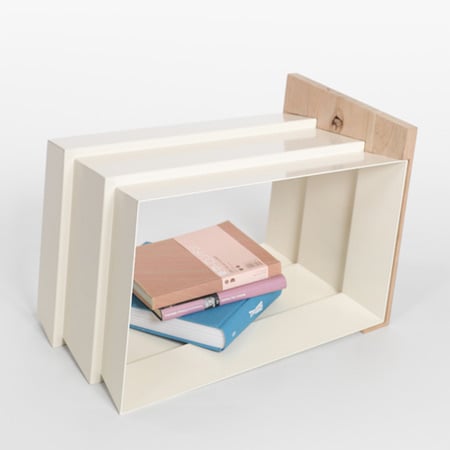
The interplay of material thickness and profile gives the frame its structure. The wood formally unbalances the frame and invites the user to explore the different functions of the object. Once Sgabello is unbalanced, new functions emerge, such as a side table or a bracket for book storage.
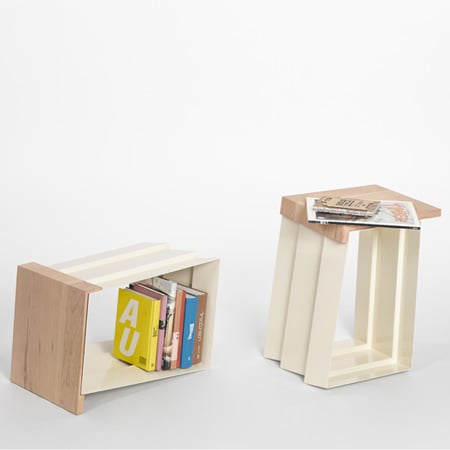
The shadows created through the metal frame, the colour of the wood and the combination of the two materials award Sgabello its own elegance. Material: Metal frame, powder-coated, solid wood plate (cherry, oak) untreated.
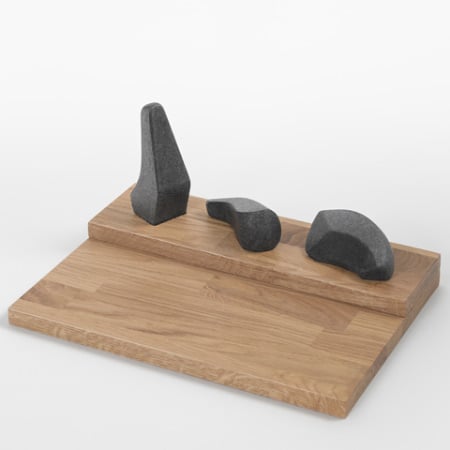
Above: Stone Tools by Christine Birkhoven. To the stone age and back: this (limited) series wants to take the preparation of foodstuffs to a sapient yet modern level. Material and craft meet each other, irreplaceable in their honesty and individuality.
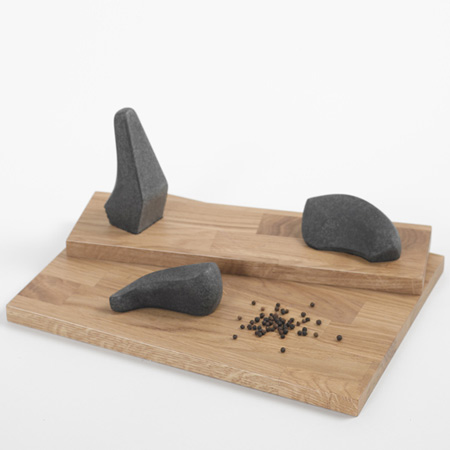
The objects are intuitive in their application, there are no directions for use or wrong ways of using them. These kitchen utensils want to be handled: to feel the heavy, cold material and to recognise its handiness will turn the preparation of food into an irresistible pleasure.

Above: Valet by Anna Blattert. Valet is an elegantly swung coatrack made from bent wood. Functionally related to the valet stand the clothes are hung on the clotheshanger for airing or hung directly over the bar.
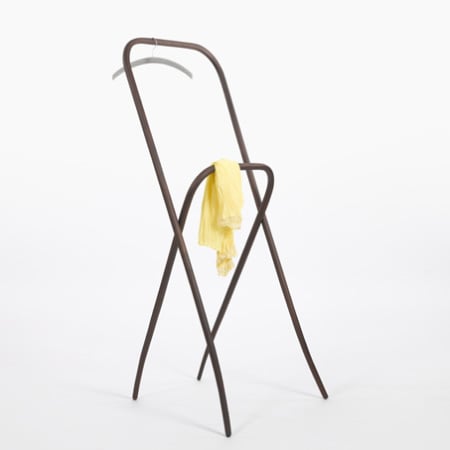
Folded up Valet takes up a minimum of space. The traditional method of steam bending takes advantage of the characteristics of the solid wood and does not require any additives.
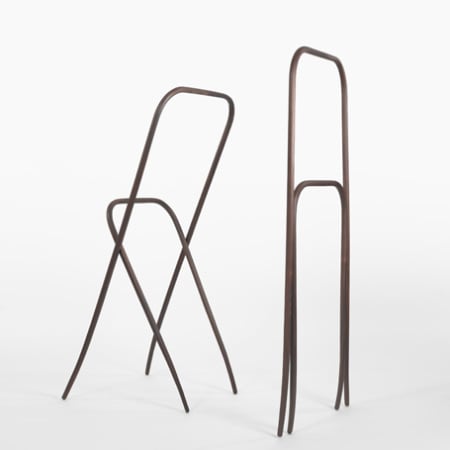
The simple folding system allows quick setup and quick storing. The airing out of garments prevents having to wash them excessively and helps to save energy. Material: Oiled nutwood or lackered ash.
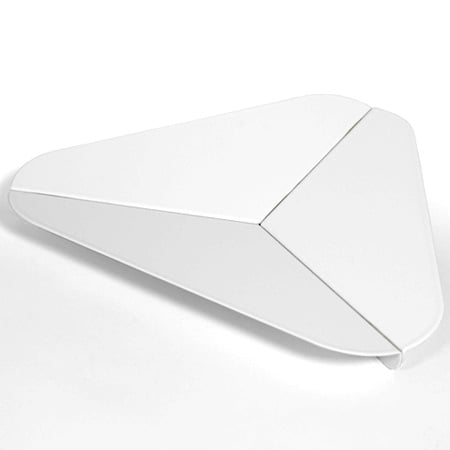
Above: Fruit Bowl Trifoglio by Thomas Walde.
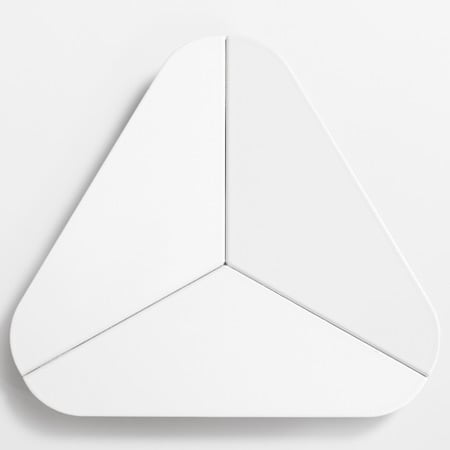
Trifoglio is a simple fruit bowl collection.
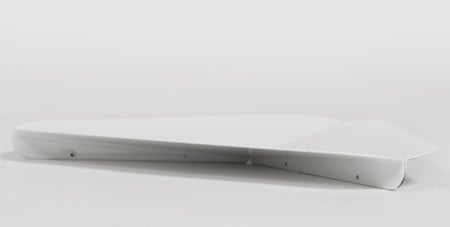
It's a new work in the context of design plattform postfossil. Material: stainless steal or enameled.
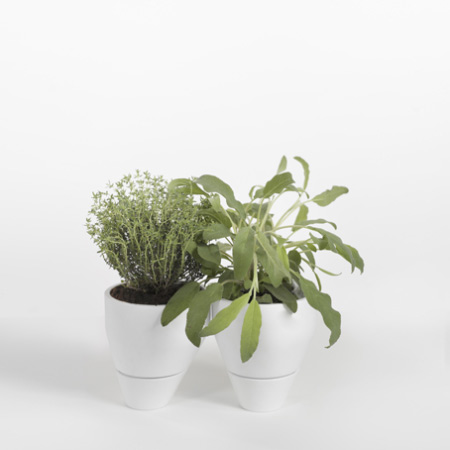
Above: VASA by Claudia Heiniger. VASA, a flowerpot for herbs. Cooking with herbs spices up life, creates breaks in the hectic everyday life, acts sustainably. In spring the herbs grow in VASA on the balcony. During the months of summer and autumn they blossom and are cut for cooking. During the winter months VASA, including the greens, moves to the kitchen – you keep cooking with taste. VASA is unbalanced and falls over unless coupled magnetically with a second form.

VASA is an invitation to spice up life with herbs – but not just one herb. Inside the porcelain form are magnets which allow for ‚docking‘ of as many herbs as possible. VASA is completed with a saucer which equally docks onto the pot magnetically. Material: Ceramic cast, magnets.
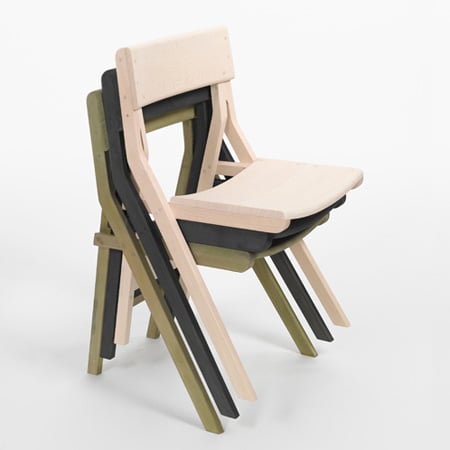
Above: JWC2 - Just Wood Chair 2 by Florian Hauswirth. The evolution of the chair which is made exclusively from wood. Just Wood Chair 2 is the evolution of the world’s first chair made exclusively from wood through the application of the wood-joining technique. This chair consists exclusively of wood and does not require glue in its assembly. The heat generated by placing the dowels releases adhesives present in the wood itself – lignin and hemicellulose – forming a substantial welded bond in seconds. The constructive design of JWC2 plays with separations and connections, formal amalgamation as well as with chequered design. You can stack up to four chairs. Material: Ashwood, Maplewood (Dowels), Color: reaction of the wood with iron oxide and tannin, Association: Sebastian Kraft from the Biel School for Wood Technology (BFH –AHB).
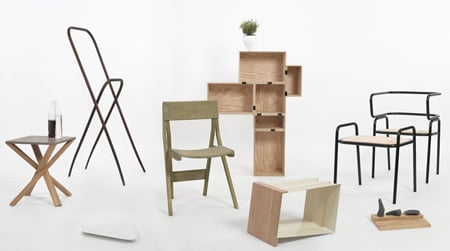
See also:
.
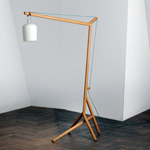 |
our special category |  |